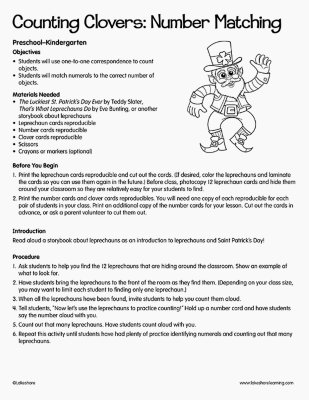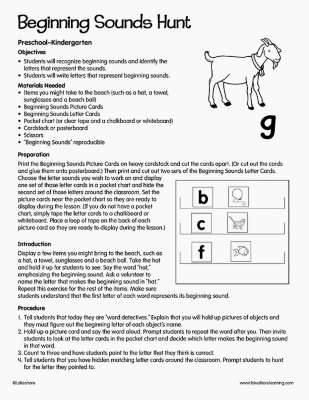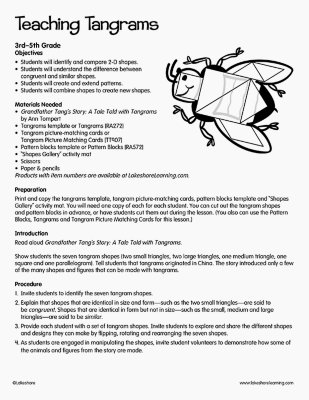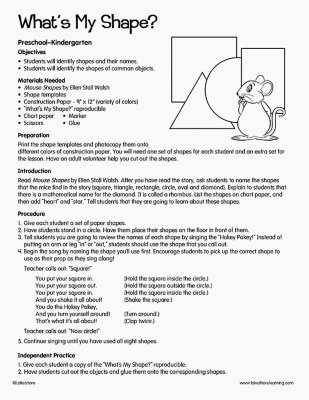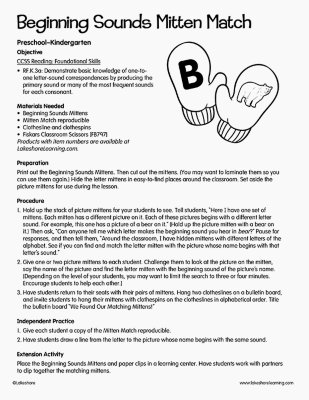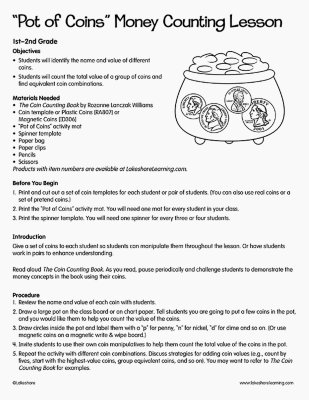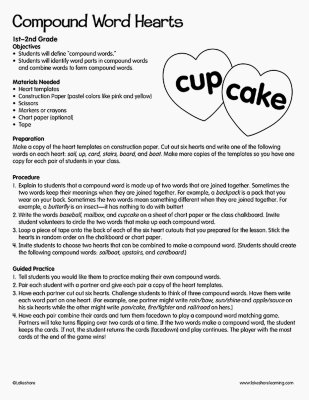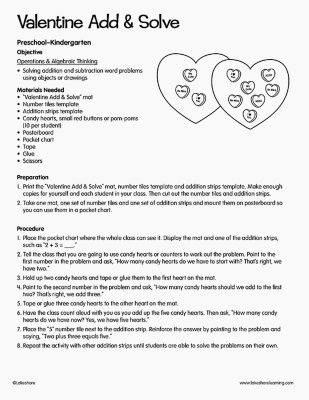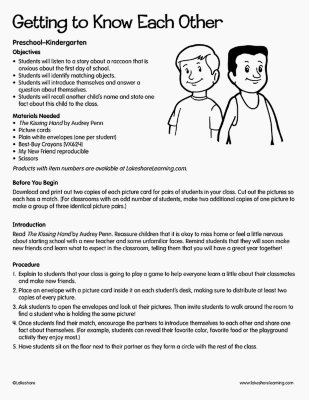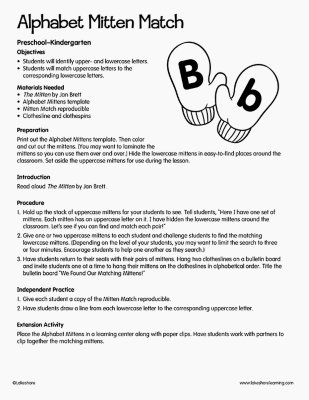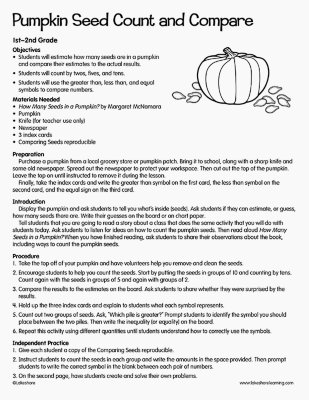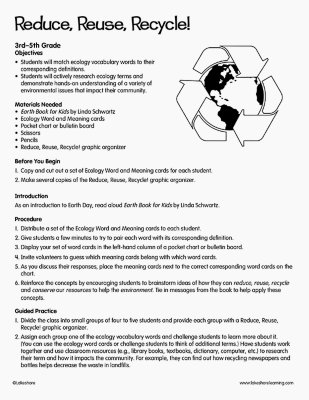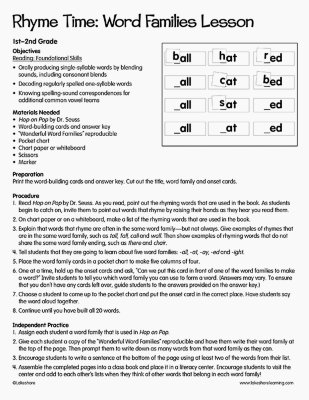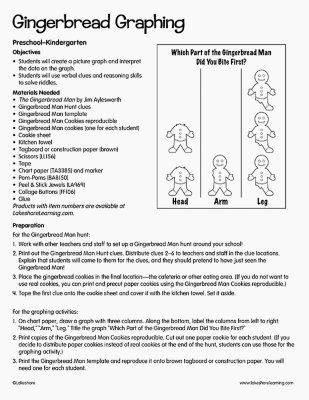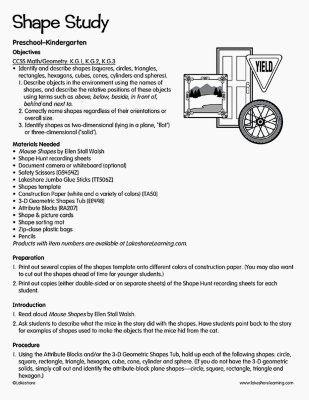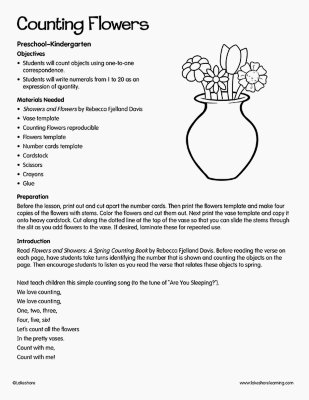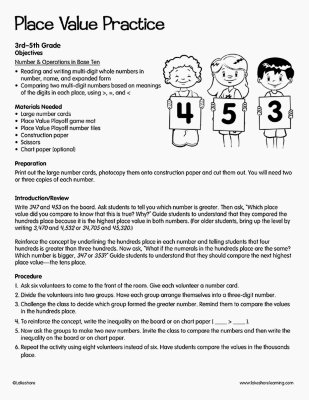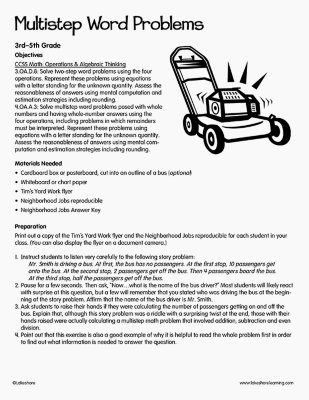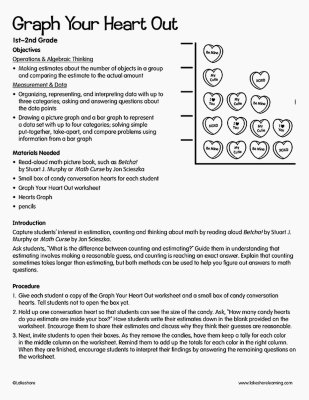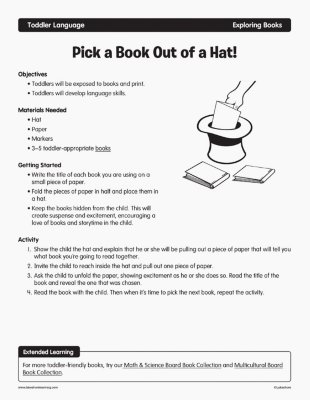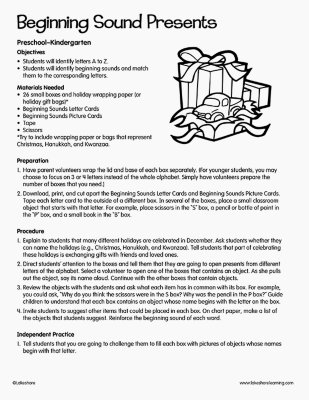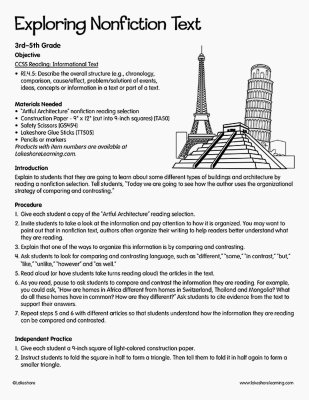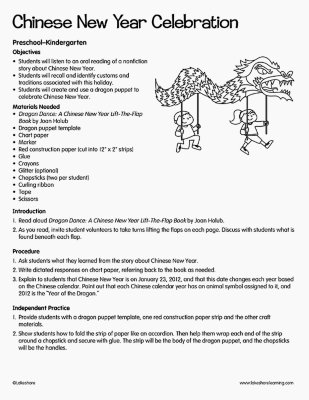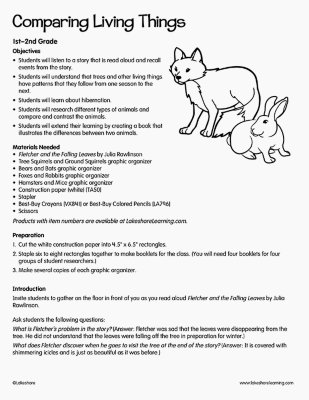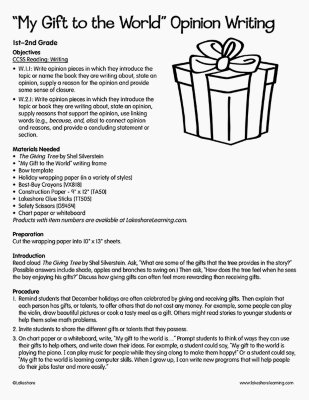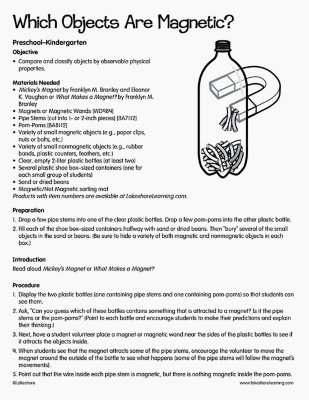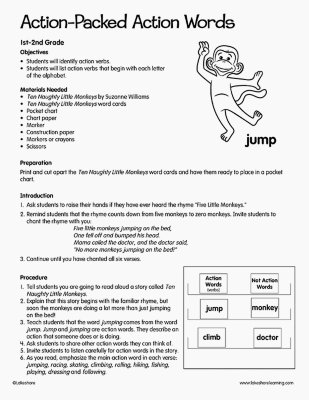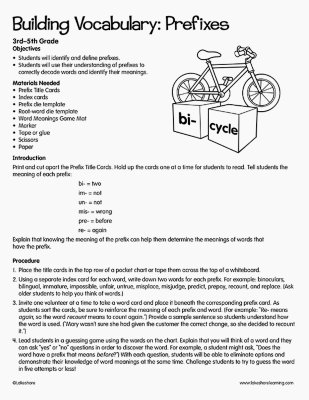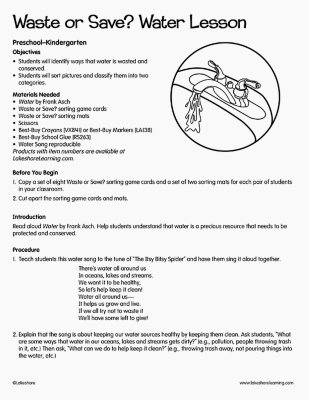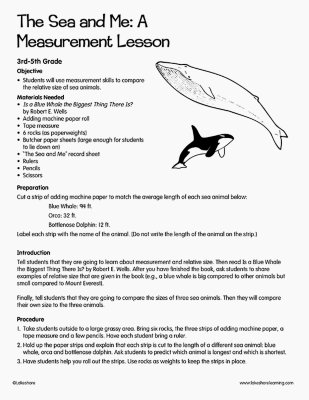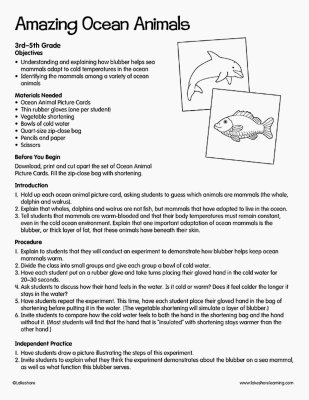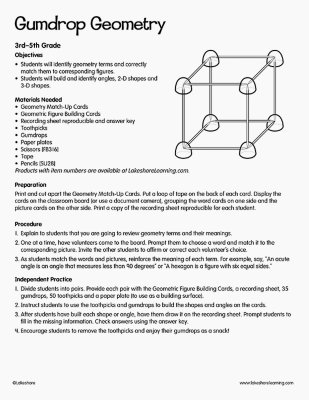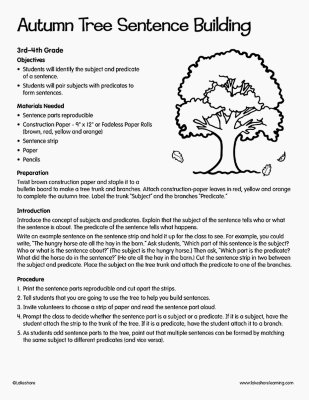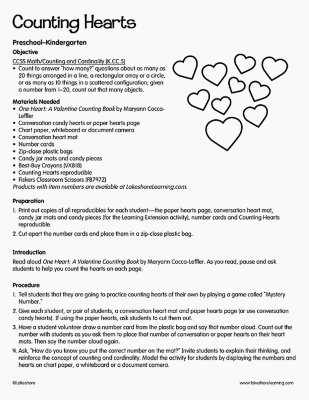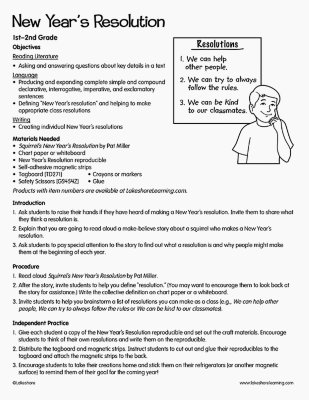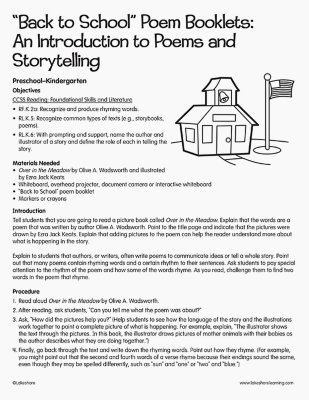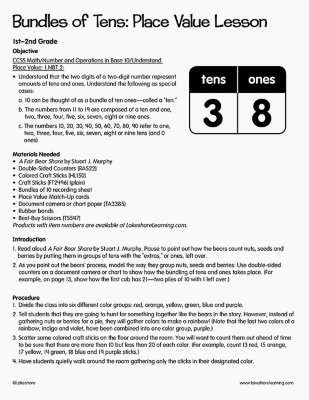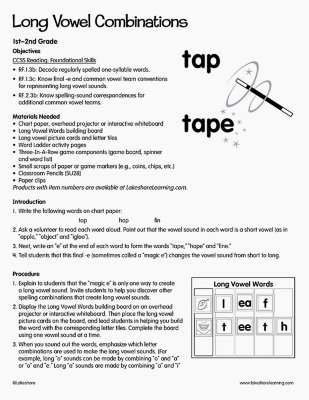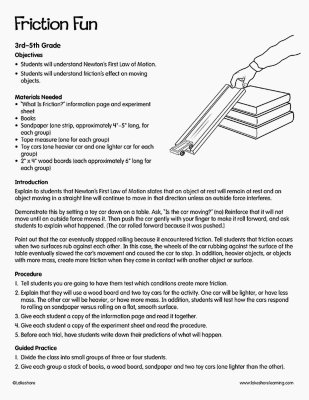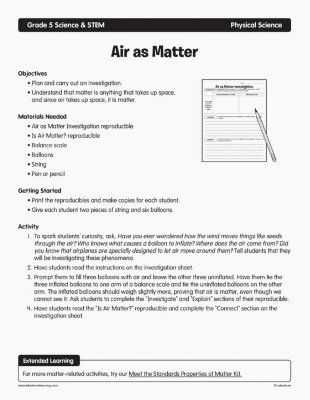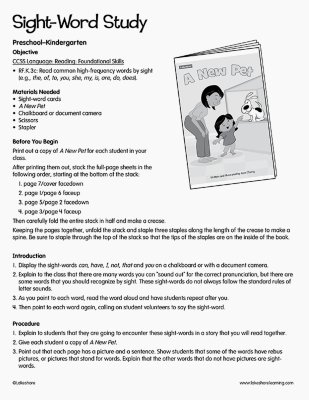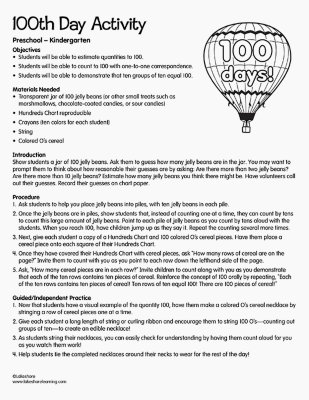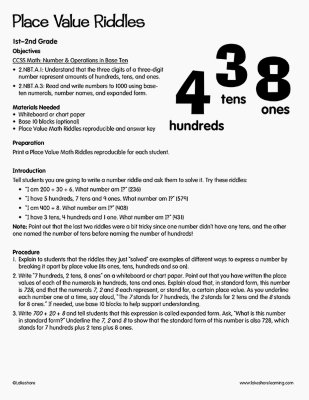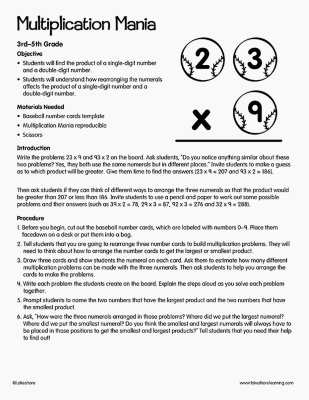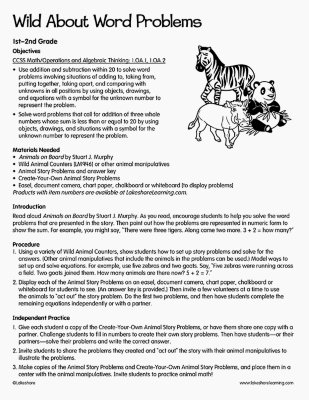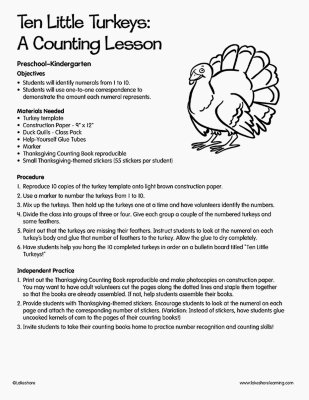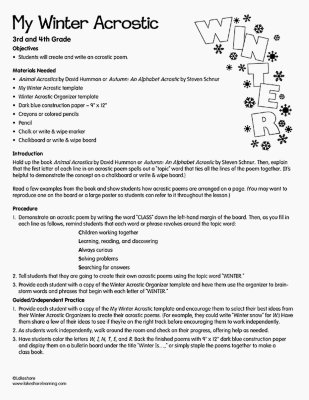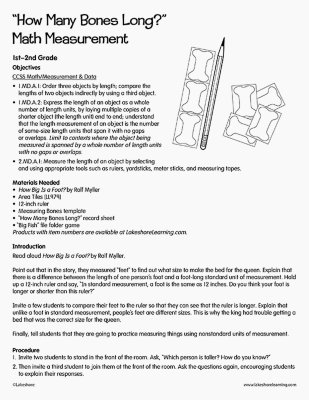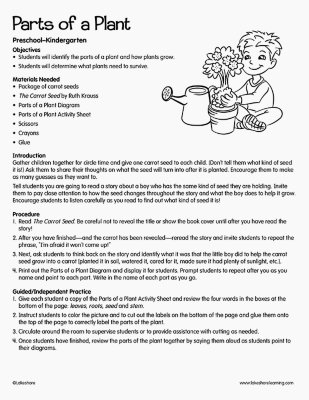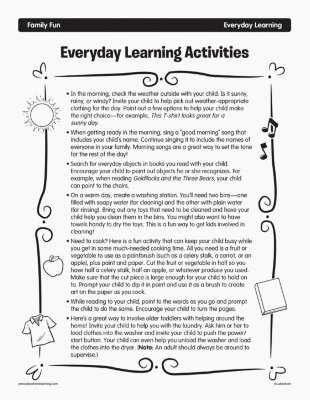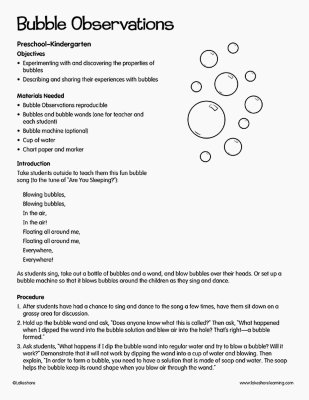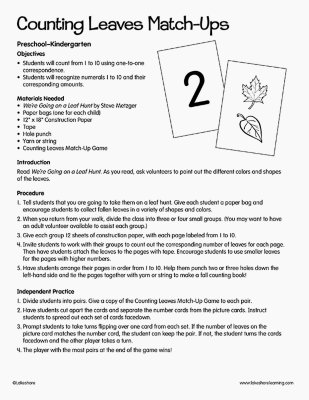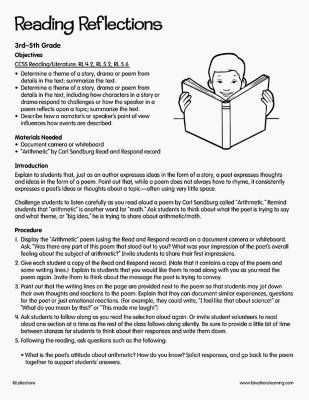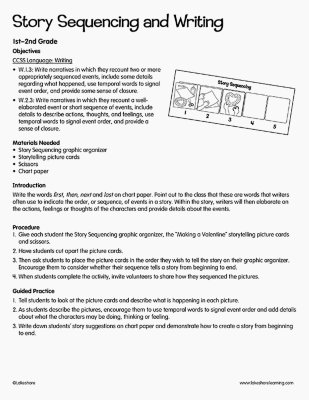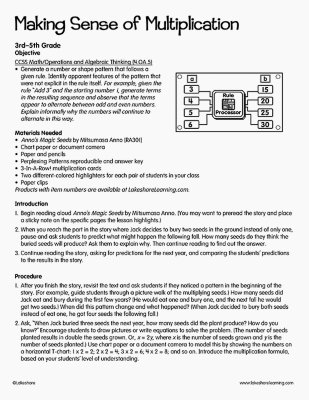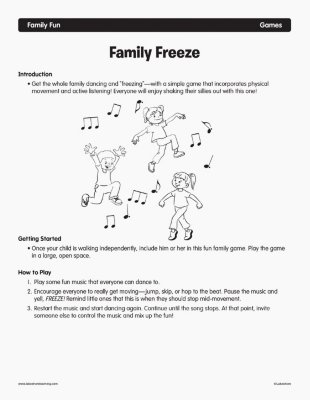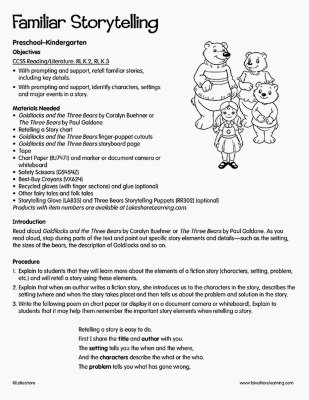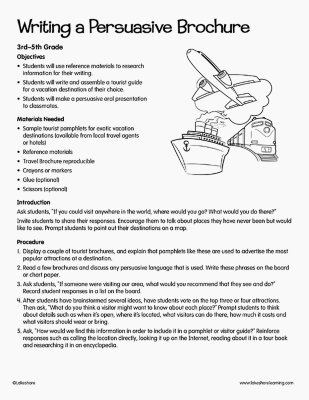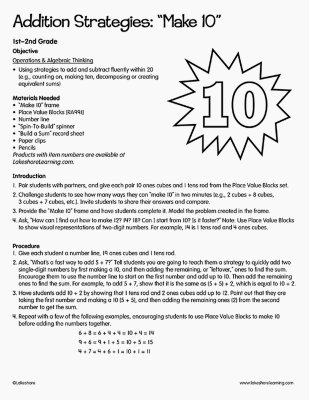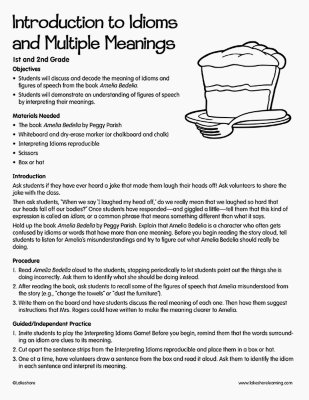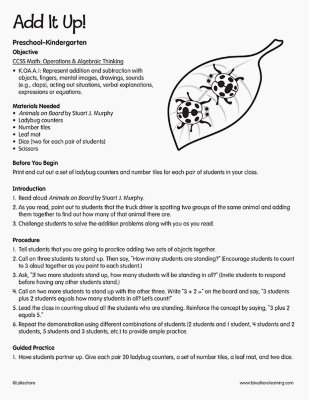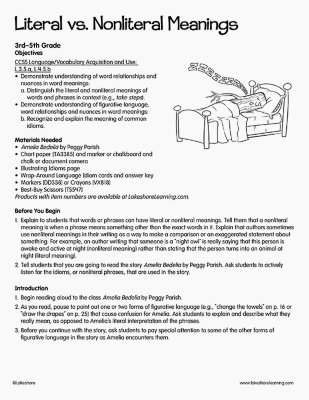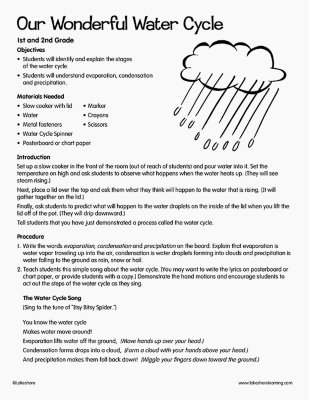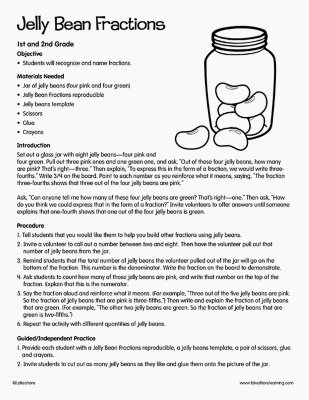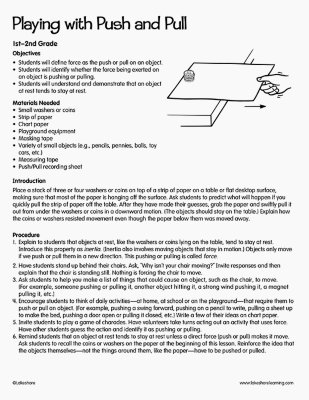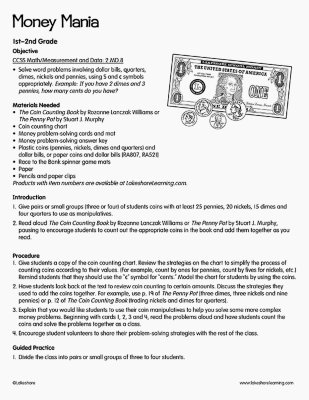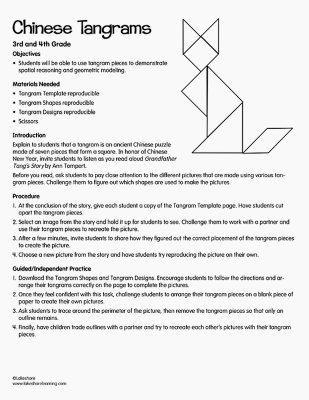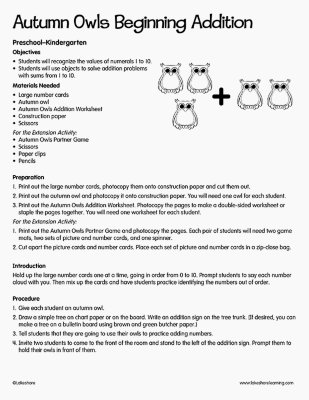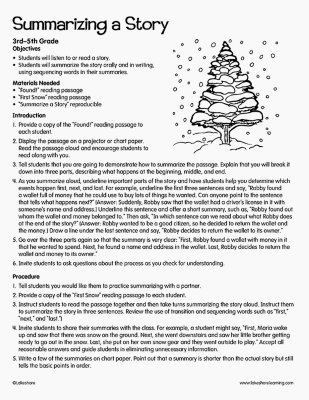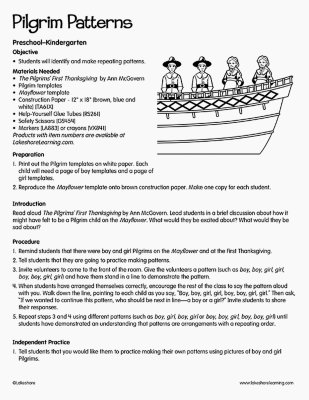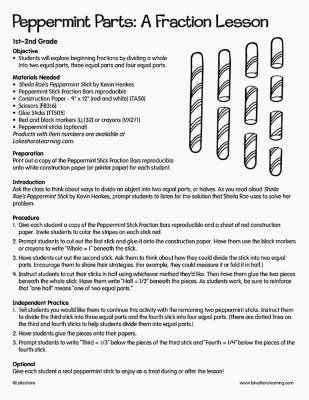Narrow by Grade
Grade
74 results for "brights 4 ever cut outs"
ITEMS:
Counting Clovers: Number Matching
Pre-K
Objectives Students will use one-to-one correspondence to count objects. Students will match numerals to the correct number of objects. Materials Needed The Luckiest St. Patrick’s Day Ever by Teddy Slater, That’s What Leprechauns Do by Eve Bunting, or another storybook about leprechauns Leprechaun cards reproducible Number cards reproducible Clover cards reproducible Scissors Crayons or markers (optional) Before You Begin Print the leprechaun cards reproducible and cut out the cards. (If desired, color the leprechauns and laminate the cards so you can use them again in the future.) Before class, photocopy 12 leprechaun cards and hide them around your classroom so they are relatively easy for your students to find. Print the number cards reproducible and clover cards reproducible. You will need one copy of each reproducible for each pair of students in your class. Print an additional copy of the number cards for your lesson. Cut out the cards in advance, or ask a parent volunteer to cut them out. Introduction Read aloud a storybook about leprechauns as an introduction to leprechauns and Saint Patrick’s Day!
View Lesson PlanBeginning Sounds Hunt
Pre-K - Kindergarten
Objectives Students will recognize beginning sounds and identify the letters that represent the sounds. Students will write letters that represent beginning sounds. Materials Needed Items you might take to the beach (such as a hat, a towel, sunglasses and a beach ball) Beginning Sounds Picture Cards Beginning Sounds Letter Cards Pocket chart (or clear tape and a chalkboard or whiteboard) Cardstock or posterboard Scissors “Beginning Sounds” reproducible Preparation: Print the Beginning Sounds Picture Cards on heavy cardstock and cut the cards apart. (Or cut out the cards and glue them onto posterboard.) Then print and cut out two sets of the Beginning Sounds Letter Cards. Choose the letter sounds you wish to work on and display one set of those letter cards in a pocket chart and hide the second set of those letters around the classroom. Set the picture cards near the pocket chart so they are ready to display during the lesson. (If you do not have a pocket chart, simply tape the letter cards to a chalkboard or whiteboard. Place a loop of tape on the back of each picture card so they are ready to display during the lesson.) Introduction Display a few items you might bring to the beach, such as a hat, a towel, sunglasses and a beach ball. Take the hat and hold it up for students to see. Say the word “hat,” emphasizing the beginning sound. Ask a volunteer to name the letter that makes the beginning sound in “hat.” Repeat this exercise for the rest of the items. Make sure students understand that the first letter of each word represents its beginning sound.
View Lesson PlanTeaching Tangrams
2nd Grade
Objectives Students will identify and compare 2-D shapes. Students will understand the difference between congruent and similar shapes. Students will create and extend patterns. Students will combine shapes to create new shapes. Materials Needed Grandfather Tang’s Story: A Tale Told with Tangrams by Ann Tompert Tangrams template or Tangrams Tangram picture-matching cards or Tangram Picture Matching Cards Pattern blocks template or Pattern Blocks “Shapes Gallery” activity mat Scissors Paper & pencils Preparation: Print and copy the tangrams template, tangram picture-matching cards, pattern blocks template and “Shapes Gallery” activity mat. You will need one copy of each for each student. You can cut out the tangram shapes and pattern blocks in advance, or have students cut them out during the lesson. (You also can use the Pattern Blocks, Tangrams and Tangram Picture Matching Cards for this lesson.) Introduction Read aloud Grandfather Tang’s Story: A Tale Told with Tangrams. Show students the seven tangram shapes (two small triangles, two large triangles, one medium triangle, one square and one parallelogram). Tell students that tangrams originated in China. The story introduced only a few of the many shapes and figures that can be made with tangrams.
View Lesson PlanWhat’s My Shape
Pre-K - Kindergarten
Objectives Students will identify shapes and their names. Students will identify the shapes of common objects. Materials Needed Mouse Shapes by Ellen Stoll Walsh Shape templates Construction Paper - 9" x 12" (variety of colors) “What’s My Shape?” reproducible Chart paper Scissors Marker glue Preparation: Print the shape templates and photocopy them onto different colors of construction paper. You will need one set of shapes for each student and an extra set for the lesson. Have an adult volunteer help you cut out the shapes. Introduction Read Mouse Shapes by Ellen Stoll Walsh. After you have read the story, ask students to name the shapes that the mice find in the story (square, triangle, rectangle, circle, oval and diamond). Explain to students that there is a mathematical name for the diamond. It is called a rhombus. List the shapes on chart paper, and then add “heart” and “star.” Tell students that they are going to learn about these shapes.
View Lesson PlanBeginning Sounds Mitten Match
Kindergarten
Objective CCSS Reading: Foundational Skills RF.K.3a: Demonstrate basic knowledge of one-to-one letter-sound correspondences by producing the primary sound or many of the most frequent sounds for each consonant. Materials Needed Beginning Sounds Mittens Mitten Match reproducible Clothesline and clothespins Fiskars classroom scissors Preparation: Print out the Beginning Sounds Mittens. Then cut out the mittens. (You may want to laminate them so you can use them again.) Hide the letter mittens in easy-to-find places around the classroom. Set aside the picture mittens for use during the lesson.
View Lesson Plan"Pot of Coins" Money Counting Lesson
2nd Grade
Objectives Students will identify the name and value of different coins. Students will count the total value of a group of coins and find equivalent coin combinations. Materials Needed The Coin Counting Book by Rozanne Lanczak Williams Coin template or Plastic Coins or Magnetic Coins “Pot of Coins” activity mat Spinner template Paper bag Paper clips Pencils Scissors Before You Begin Print and cut out a set of coin templates for each student or pair of students. (You can also use real coins or a set of pretend coins.) Print the “Pot of Coins” activity mat. You will need one mat for every student in your class. Print the spinner template. You will need one spinner for every three or four students. Introduction Give a set of coins to each student so students can manipulate them throughout the lesson. Or have students work in pairs to enhance understanding. Read aloud The Coin Counting Book. As you read, pause periodically and challenge students to demonstrate the money concepts in the book using their coins.
View Lesson PlanCompound Word Hearts
1st Grade - 2nd Grade
Objectives Students will define “compound words.” Students will identify word parts in compound words and combine words to form compound words. Materials Needed Heart templates Construction Paper - 9" x 12" (pastel colors like pink and yellow) Scissors Markers or crayons Chart paper (optional) Tape Preparation Make a copy of the heart templates on construction paper. Cut out six hearts and write one of the following words on each heart: sail, up, card, stairs, board, and boat. Make more copies of the templates so you have one copy for each pair of students in your class.
View Lesson PlanValentine Add & Solve
Pre-K - Kindergarten
Objective Operations & Algebraic Thinking Solving addition and subtraction word problems using objects or drawings Materials Needed “Valentine Add & Solve” mat Number tiles template Addition strips template Candy hearts, small red buttons or pom-poms (10 per student) Posterboard Pocket chart Tape Glue Scissors Preparation Print the “Valentine Add & Solve” mat, number tiles template and addition strips template. Make enough copies for yourself and each student in your class. Then cut out the number tiles and addition strips. Take one mat, one set of number tiles and one set of addition strips and mount them on posterboard so you can use them in a pocket chart.
View Lesson PlanGetting to Know Each Other
Pre-K - Kindergarten
Objectives Students will listen to a story about a raccoon that is anxious about the first day of school. Students will identify matching objects. Students will introduce themselves and answer a question about themselves. Students will recall another child’s name and state one fact about this child to the class. Materials Needed The Kissing Hand by Audrey Penn Picture cards Plain white envelopes (one per student) Best-Buy Crayons My New Friend reproducible Scissors Before You Begin Download and print out two copies of each picture card for pairs of students in your class. Cut out the pictures so each has a match. (For classrooms with an odd number of students, make two additional copies of one picture to make a group of three identical picture pairs.) Introduction Read The Kissing Hand by Audrey Penn. Reassure children that it is okay to miss home or feel a little nervous about starting school with a new teacher and some unfamiliar faces. Remind students that they will soon make new friends and learn what to expect in the classroom, telling them that you will have a great year together!
View Lesson PlanAlphabet Mitten Match
Pre-K - Kindergarten
Objectives Students will identify upper - and lowercase letters. Students will match uppercase letters to the corresponding lowercase letters. Materials Needed The Mitten by Jan Brett Alphabet Mittens template Mitten Match reproducible Clothesline and clothespins Preparation. Print out the Alphabet Mittens template. Then color and cut out the mittens. (You may want to laminate the mittens so you can use them over and over.) Hide the lowercase mittens in easy–to–find places around the classroom. Set aside the uppercase mittens for use during the lesson.
View Lesson PlanPumpkin Seed Count and Compare
1st Grade - 2nd Grade
Objectives Students will estimate how many seeds are in a pumpkin and compare their estimates to the actual results. Students will count by twos, fives, and tens. Students will use the greater than, less than and equal symbols to compare numbers. Materials Needed How Many Seeds in a Pumpkin? by Margaret McNamara Pumpkin Knife (for teacher use only) Newspaper 3 index cards Comparing Seeds reproducible Preparation: Purchase a pumpkin from a local grocery store or pumpkin patch. Bring it to school, along with a sharp knife and some old newspaper. Spread out the newspaper to protect your workspace. Then cut out the top of the pumpkin. Leave the top on until instructed to remove it during the lesson. Finally, take the index cards and write the greater than symbol on the first card, the less than symbol on the second card, and the equal sign on the third card. Introduction Display the pumpkin and ask students to tell you what’s inside (seeds). Ask students if they can estimate, or guess, how many seeds there are. Write their guesses on the board or on chart paper. Tell students that you are going to read a story about a class that does the same activity that you will do with students today. Ask students to listen for ideas on how to count the pumpkin seeds. Then read aloud How Many Seeds in a Pumpkin? When you have finished reading, ask students to share their observations about the book, including ways to count the pumpkin seeds.
View Lesson PlanReduce, Reuse, Recycle!
4th Grade
Objectives Students will match ecology vocabulary words to their corresponding definitions. Students will actively research ecology terms and demonstrate hands-on understanding of a variety of environmental issues that impact their community. Materials Needed Earth Book for Kids by Linda Schwartz Ecology Word and Meaning cards Pocket chart or bulletin board Scissors Pencils Reduce, Reuse, Recycle! graphic organizer Before You Begin Copy and cut out a set of Ecology Word and Meaning cards for each student. Make several copies of the Reduce, Reuse, Recycle! graphic organizer. Introduction As an introduction to Earth Day, read aloud Earth Book for Kids by Linda Schwartz.
View Lesson PlanRhyme Time: Word Families Lesson
1st Grade - 2nd Grade
Objectives Reading: Foundational Skills Orally producing single-syllable words by blending sounds, including consonant blends Decoding regularly spelled one-syllable words Knowing spelling-sound correspondences for additional common vowel teams Materials Needed Hop on Pop by Dr. Seuss Word-building cards and answer key “Wonderful Word Families” reproducible Pocket chart Chart paper or whiteboard Scissors Marker Preparation Print the word-building cards and answer key. Cut out the title, word family and onset cards.
View Lesson PlanGingerbread Graphing
Pre-K
Objectives Students will create a picture graph and interpret the data on the graph. Students will use verbal clues and reasoning skills to solve riddles. Materials Needed The Gingerbread Man by Jim Aylesworth Gingerbread Man Hunt clues Gingerbread Man template Gingerbread Man Cookies reproducible Scissors Gingerbread Man cookies (one for each student) Cookie sheet Kitchen towel Tagboard or construction paper (brown) Tape Chart paper and marker Pom-Poms Peel & Stick Jewels Collage Buttons Glue Preparation: For the Gingerbread Man hunt: Work with other teachers and staff to set up a Gingerbread Man hunt around your school! Print out the Gingerbread Man Hunt clues. Distribute clues 2 - 6 to the teachers and staff in the clue locations. Explain that students will come to them for the clues, and they should pretend to have just seen the Gingerbread Man! Place the gingerbread cookies in the final location—the cafeteria or other eating area. (If you do not want to use real cookies, you can print and precut paper cookies using the Gingerbread Man Cookies reproducible.) Tape the first clue onto the cookie sheet and cover it with the kitchen towel. Set it aside. For the graphing activities: On chart paper, draw a graph with three columns. Along the bottom, label the columns from left to right: “Head,” “Arm,” and “Leg.” Title the graph “Which Part of the Gingerbread Man Did You Bite First?” Print copies of the Gingerbread Man Cookies reproducible. Cut out one paper cookie for each student. (If you decide to distribute paper cookies instead of real cookies at the end of the hunt, students can use those for the graphing activity.) Print the Gingerbread Man template and reproduce it onto brown tagboard or construction paper. You will need one for each student. Introduction Read aloud The Gingerbread Man by Jim Aylesworth. After the story, tell students that you have prepared a Gingerbread Man cookie for them to eat. (If you are not using real cookies, tell students you have made a paper cookie for them to use in a special math project.) Then take out the covered cookie sheet and pull off the towel. Act surprised as you announce, “Oh no, our Gingerbread Man has run away! Look, he left a note for us to read!” Read the clue aloud to students.
View Lesson PlanShape Study
Kindergarten
Objectives CCSS Math/Geometry: K.G.1, K.G.2, K.G.3 Identify and describe shapes (squares, circles, triangles, rectangles, hexagons, cubes, cones, cylinders and spheres). Describe objects in the environment using the names of shapes, and describe the relative positions of these objects using terms such as above, below, beside, in front of, behind and next to. Correctly name shapes regardless of their orientations or overall size. Identify shapes as two-dimensional (lying in a plane, “flat”) or three-dimensional (“solid”). Materials Needed Mouse Shapes by Ellen Stoll Walsh Shape Hunt recording sheets Document camera or whiteboard (optional) Safety Scissors Lakeshore Jumbo Glue Sticks Shapes template Construction Paper (white and a variety of colors) 3-D Geometric Shapes Tub Attribute Blocks Shape & picture cards Shape sorting mat Zip-close plastic bags Pencils Preparation Print out several copies of the shapes template onto different colors of construction paper. (You may also want to cut out the shapes ahead of time for younger students.) Print out copies (either double-sided or on separate sheets) of the Shape Hunt recording sheets for each student. Introduction Read aloud Mouse Shapes by Ellen Stoll Walsh. Ask students to describe what the mice in the story did with the shapes. Have students point back to the story for examples of shapes used to make the objects that the mice hid from the cat.
View Lesson PlanCounting Apples
Kindergarten
Objectives CCSS Math/Counting & Cardinality K.CC.B.4: Understand the relationship between numbers and quantities; connect counting to cardinality. K.CC.B.5: Count to answer “how many?” questions about as many as 20 things arranged in a line, a rectangular array, or a circle, or as many as 10 things in a scattered configuration; given a number from 1?20, count out that many objects. Materials Needed The Very Hungry Caterpillar by Eric Carle Apple Doodle Apple Accents or large apple template and Construction Paper - 9" x 12" (red) Apple Tree counting mat Apple counters (20 per student) Thin-Line Permanent Markers - Black Photo of each student from the shoulders up (Photos shouldn't measure more than 4" high.) Construction Paper - 12" x 18" “I have ______ apples up on top!” writing frame Lakeshore Glue Sticks Safety Scissors Tape Preparation: Count out a set of 20 Apple Doodle Apple Accents and use a marker to number them from 1 to 20. Or, if you prefer, download and print out the large apple template and trace it onto red construction paper. Use scissors to make 20 large apple cutouts, and then number the cutouts from 1 to 20. Introduction Read aloud The Very Hungry Caterpillar by Eric Carle. As you read, point to the apples on top of the characters? heads and have the class count them aloud together.
View Lesson PlanCounting Flowers
Pre-K
Objectives Students will count objects using one-to-one correspondence. Students will write numerals from 1 to 20 as an expression of quantity. Materials Needed Flowers and Showers: A Spring Counting Book by Rebecca Fjelland Davis Vase template Counting Flowers reproducible Flowers template Number cards template Cardstock Scissors Crayons Glue Preparation: Before the lesson, print out and cut apart the number cards template. Then print the flowers template and make four copies of the flowers with stems. Color the flowers and cut them out. Next print the vase template and copy it onto heavy cardstock. Cut along the dotted line at the top of the vase so that you can slide the stems through the slit as you add flowers to the vase. If desired, laminate these for repeated use. Introduction Read Flowers and Showers: A Spring Counting Book by Rebecca Fjelland Davis. Before reading the verse on each page, have students take turns identifying the number that is shown and counting the objects on the page. Then encourage students to listen as you read the verse that relates these objects to spring. Next teach children this simple counting song (to the tune of “Are You Sleeping?”). We love counting, We love counting, One, two, three, Four, five, six! Let’s count all the flowers In the pretty vases. Count with me, Count with me!
View Lesson PlanPlace Value Practice
4th Grade
Objectives Number & Operations in Base Ten Reading and writing multi-digit whole numbers in number, name, and expanded form Comparing two multi-digit numbers based on meanings of the digits in each place, using >, =, and < Materials Needed Large number cards Place Value Playoff game mat Place Value Playoff number tiles Construction paper Scissors Chart paper (optional) Preparation: Print out the large number cards, photocopy them onto construction paper and cut them out. You will need two or three copies of each number. Introduction/Review Write 347 and 453 on the board. Ask students to tell you which number is greater. Then ask, “Which place value did you compare to know that this is true? Why?” Guide students to understand that they compared the hundreds place because it is the highest place value in both numbers. (For older students, bring up the level by writing 3,470 and 4,532 or 34,705 and 45,320.) Reinforce the concept by underlining the hundreds place in each number and telling students that four hundreds is greater than three hundreds. Now ask, “What if the numerals in the hundreds place are the same? Which number is bigger, 347 or 353?” Guide students to understand that they should compare the next highest place value—the tens place.
View Lesson PlanMultistep Word Problems
3rd Grade
Objectives CCSS Math: Operations & Algebraic Thinking 3.OA.D.8: Solve two-step word problems using the four operations. Represent these problems using equations with a letter standing for the unknown quantity. Assess the reasonableness of answers using mental computation and estimation strategies including rounding. 4.OA.A.3: Solve multistep word problems posed with whole numbers and having whole-number answers using the four operations, including problems in which remainders must be interpreted. Represent these problems using equations with a letter standing for the unknown quantity. Assess the reasonableness of answers using mental computation and estimation strategies including rounding. Materials Needed Cardboard box or posterboard, cut into an outline of a bus (optional) Whiteboard or chart paper Tim’s Yard Work flyer Neighborhood Jobs reproducible Neighborhood Jobs Answer Key Preparation Print out a copy of the Tim’s Yard Work flyer and the Neighborhood Jobs reproducible for each student in your class. (You can also display the flyer on a document camera.) Introduction Instruct students to listen very carefully to the following story problem: Mr. Smith is driving a bus. At first, the bus has no passengers. At the first stop, 10 passengers get onto the bus. At the second stop, 2 passengers get off the bus. Then 4 passengers board the bus. At the third stop, half the passengers get off the bus. Pause for a few seconds. Then ask, “Now...what is the name of the bus driver?” Most students will likely react with surprise at this question, but a few will remember that you stated who was driving the bus at the beginning of the story problem. Affirm that the name of the bus driver is Mr. Smith. Ask students to raise their hands if they were calculating the number of passengers getting on and off the bus. Explain that, although this story problem was a riddle with a surprising twist at the end, those with their hands raised were actually calculating a multistep math problem that involved addition, subtraction and even division. Point out that this exercise is also a good example of why it is helpful to read the whole problem first in order to find out what information is needed to answer the question.
View Lesson PlanGraph Your Heart Out
1st Grade - 2nd Grade
Objectives Operations & Algebraic Thinking Making estimates about the number of objects in a group and comparing the estimate to the actual amount Measurement & Data Organizing, representing, and interpreting data with up to three categories; asking and answering questions about the data points Drawing a picture graph and a bar graph to represent a data set with up to four categories; solving simple put-together, take-apart, and compare problems using information from a bar graph Materials Needed Read-aloud math picture book, such as Betcha! by Stuart J. Murphy or Math Curse by Jon Scieszka Small box of candy conversation hearts for each student Graph Your Heart Out worksheet Hearts Graph pencils Introduction Capture students’ interest in estimation, counting and thinking about math by reading aloud Betcha! by Stuart J. Murphy or Math Curse by Jon Scieszka. Ask students, “What is the difference between counting and estimating?” Guide them in understanding that estimating involves making a reasonable guess, and counting is reaching an exact answer. Explain that counting sometimes takes longer than estimating, but both methods can be used to help you figure out answers to math questions.
View Lesson PlanPick a Book Out of a Hat!
Toddler
Objectives
• Toddlers will be exposed to books and print.
• Toddlers will develop language skills.
Beginning Sound Presents
Pre-K - Kindergarten
Objectives Students will identify letters A to Z. Students will identify beginning sounds and match them to the corresponding letters. Materials Needed 26 small boxes and holiday wrapping paper (or holiday gift bags)* Beginning Sounds Letter Cards Beginning Sounds Picture Cards Tape Scissors *Try to include wrapping paper or bags that represent Christmas, Hanukkah, and Kwanzaa. Preparation. Have parent volunteers wrap the lid and base of each box separately. (For younger students, you may choose to focus on 3 or 4 letters instead of the whole alphabet. Simply have volunteers prepare the number of boxes that you need.) Download, print, and cut apart the Beginning Sounds Letter Cards and Beginning Sounds Picture Cards. Tape each letter card to the outside of a different box. In several of the boxes, place a small classroom object that starts with that letter. For example, place scissors in the “S” box, a pencil or bottle of paint in the “P” box, and a small book in the “B” box.
View Lesson PlanExploring Nonfiction Text
1st Grade - 2nd Grade
Objective CCSS Reading: Informational Text RI.4.5: Describe the overall structure (e.g., chronology, comparison, cause/effect, problem/solution) of events, ideas, concepts or information in a text or part of a text. Materials Needed “Artful Architecture” nonfiction reading selection Construction Paper - 9" x 12" (cut into 9-inch squares) Safety Scissors Lakeshore Glue Sticks Pencils or markers Introduction Explain to students that they are going to learn about some different types of buildings and architecture by reading a nonfiction selection. Tell students, “Today we are going to see how the author uses the organizational strategy of comparing and contrasting.”
View Lesson PlanChinese New Year Celebration
Pre-K - 1st Grade
Objectives Students will listen to an oral reading of a nonfiction story about Chinese New Year. Students will recall and identify customs and traditions associated with this holiday. Students will create and use a dragon puppet to celebrate Chinese New Year. Materials Needed Dragon Dance: A Chinese New Year Lift-The-Flap Book by Joan Holub Dragon puppet template Chart paper Marker Red construction paper (cut into 12" x 2" strips) Glue Crayons Glitter (optional) Chopsticks (two per student) Curling ribbon Tape Scissors Introduction Read aloud Dragon Dance: A Chinese New Year Lift-the-Flap Book by Joan Holub. As you read, invite student volunteers to take turns lifting the flaps on each page. Discuss with students what is found beneath each flap.
View Lesson PlanComparing Living Things
1st Grade
Objectives Students will listen to a story that is read aloud and recall events from the story. Students will understand that trees and other living things have patterns that they follow from one season to the next. Students will learn about hibernation. Students will research different types of animals and compare and contrast the animals. Students will extend their learning by creating a book that illustrates the differences between two animals. Materials Needed Fletcher and the Falling Leaves by Julia Rawlinson Tree Squirrels and Ground Squirrels graphic organizer Bears and Bats graphic organizer Foxes and Rabbits graphic organizer Hamsters and Mice graphic organizer Construction paper (white) Stapler Best-Buy Crayons or Best-Buy Colored Pencils Scissors Preparation Cut the white construction paper into 4.5" x 6.5" rectangles. Staple six to eight rectangles together to make booklets for the class. (You will need four booklets for four groups of student researchers.) Make several copies of each graphic organizer. Introduction Invite students to gather on the floor in front of you as you read aloud Fletcher and the Falling Leaves by Julia Rawlinson. Ask students the following questions: What is Fletcher’s problem in the story? (Answer: Fletcher was sad that the leaves were disappearing from the tree. He did not understand that the leaves were falling off the tree in preparation for winter.) What does Fletcher discover when he goes to visit the tree at the end of the story? (Answer: It is covered with shimmering icicles and is just as beautiful as it was before.)
View Lesson PlanMy Gift to the World Opinion Writing
1st Grade - 2nd Grade
Objectives CCSS Reading: Writing W.1.1: Write opinion pieces in which they introduce the topic or name the book they are writing about, state an opinion, supply a reason for the opinion and provide some sense of closure. W.2.1: Write opinion pieces in which they introduce the topic or book they are writing about, state an opinion, supply reasons that support the opinion, use linking words (e.g., because, and, also) to connect opinion and reasons, and provide a concluding statement or section. Materials Needed The Giving Tree by Shel Silverstein “My Gift to the World” writing frame Bow template Holiday wrapping paper (in a variety of styles) Best-Buy Crayons Construction Paper - 9" x 12" Lakeshore Glue Sticks Safety Scissors Chart paper or whiteboard Preparation: Cut the wrapping paper into 10" x 13" sheets. Introduction Read The Giving Tree by Shel Silverstein. Ask, “What are some of the gifts that the tree provides in the story?” (Possible answers include shade, apples and branches to swing on.) Then ask, “How does the tree feel when he sees the boy enjoying his gifts?” Discuss how giving gifts can often feel more rewarding than receiving gifts.
View Lesson PlanWhich Objects Are Magnetic?
Pre-K
Objective Compare and classify objects by observable physical properties. Materials Needed Mickey’s Magnet by Franklyn M. Branley and Eleanor K. Vaughan or What Makes a Magnet? by Franklyn M. Branley Magnets or Magnetic Wands Pipe Stems (cut into 1-or 2-inch pieces) Pom-Poms Variety of small magnetic objects (e.g., paper clips, nuts or bolts, etc.) Variety of small nonmagnetic objects (e.g., rubber bands, plastic counters, feathers, etc.) Clear, empty 2-liter plastic bottles (at least two) Several plastic shoe box–sized containers (one for each small group of students) Sand or dried beans Magnetic/Not Magnetic sorting mat Introduction Read aloud Mickey’s Magnet or What Makes a Magnet?
View Lesson PlanAction-Packed Action Words
1st Grade
Objectives Students will identify action verbs. Students will list action verbs that begin with each letter of the alphabet. Materials Needed Ten Naughty Little Monkeys by Suzanne Williams Ten Naughty Little Monkeys Word Cards Pocket chart Chart paper Marker Construction paper Markers or crayons Scissors Preparation: Print and cut apart the Ten Naughty Little Monkeys word cards and have them ready to place in a pocket chart. Introduction Ask students to raise their hands if they have ever heard the rhyme “Five Little Monkeys.” Remind students that the rhyme counts down from five monkeys to zero monkeys. Invite students to chant the rhyme with you: Five little monkeys jumping on the bed, One fell off and bumped his head. Mama called the doctor, and the doctor said, “No more monkeys jumping on the bed!” Continue until you have chanted all six verses.
View Lesson PlanBuilding Vocabulary: Prefixes
3rd Grade - 4th Grade
Objectives Identifying and knowing the meaning of the most common prefixes and derivational suffixes Determining the meaning of the new word formed when a known affix is added to a known word Using common, grade-appropriate Greek and Latin affixes and roots as clues to the meaning of a word Materials Needed Prefix title cards Index cards Prefix die template Root-word die template Word meanings game mat Marker Tape or glue Scissors Paper Pocket chart or whiteboard Introduction Print and cut apart the prefix title cards. Hold up the cards one at a time for students to read. Tell students the meaning of each prefix: bi- = two im- = not un- = not mis- = wrong pre- = before re- = again Explain that knowing the meaning of the prefix can help them determine the meanings of words that have the prefix.
View Lesson PlanWaste or Save? Water Lesson
Kindergarten
Objectives Students will identify ways that water is wasted and conserved. Students will sort pictures and classify them into two categories. Materials Needed Water by Frank Asch Waste or Save? sorting game cards Waste or Save? sorting mats Scissors Best-Buy Crayons or Best-Buy Markers Best-Buy School Glue Water Song reproducible Before You Begin Copy a set of eight Waste or Save? sorting game cards and a set of two sorting mats for each pair of students in your classroom. Cut apart the sorting game cards and mats. Introduction Read aloud Water by Frank Asch. Help students understand that water is a precious resource that needs to be protected and conserved.
View Lesson PlanThe Sea and Me: A Measurement Lesson
3rd Grade
Objective Students will use measurement skills to compare the relative size of sea animals. Materials Needed Is a Blue Whale the Biggest Thing There Is? by Robert E. Wells Adding machine paper roll Tape measure 6 rocks (as paperweights) Butcher paper sheets (large enough for students to lie down on) “The Sea and Me” Record Sheet Rulers Pencils Scissors Preparation: Cut a strip of adding machine paper to match the average length of each sea animal below: Blue Whale: 94 ft. Orca: 32 ft. Bottlenose Dolphin: 12 ft. Label each strip with the name of the animal. (Do not write the length of the animal on the strip.) Introduction Tell students that they are going to learn about measurement and relative size. Then read Is a Blue Whale the Biggest Thing There Is? by Robert E. Wells. After you have finished the book, ask students to share examples of relative size that are given in the book (e.g., a blue whale is big compared to other animals but small compared to Mount Everest). Finally, tell students that they are going to compare the sizes of three sea animals. Then they will compare their own size to the three animals.
View Lesson PlanAmazing Ocean Animals
3rd Grade
Objectives Understanding and explaining how blubber helps sea mammals adapt to cold temperatures in the ocean Identifying the mammals among a variety of ocean animals Materials Needed Ocean Animal Picture Cards Thin rubber gloves (one per student) Vegetable shortening Bowls of cold water Quart-size zip-close bag Pencils and paper Scissors Before You Begin Download, print and cut apart the set of Ocean Animal Picture Cards. Fill the zip-close bag with shortening. Introduction Hold up each ocean animal picture card, asking students to guess which animals are mammals (the whale, dolphin and walrus). Explain that whales, dolphins and walrus are not fish, but mammals that have adapted to live in the ocean. Tell students that mammals are warm-blooded and that their body temperatures must remain constant, even in the cold ocean environment. Explain that one important adaptation of ocean mammals is the blubber, or thick layer of fat, that these animals have beneath their skin.
View Lesson PlanGumdrop Geometry
4th Grade
Objectives Students will identify geometry terms and correctly match them to corresponding figures. Students will build and identify angles, 2-D shapes and 3-D shapes. Materials Needed Geometry Match-Up Cards Geometric Figure Building Cards Recording sheet reproducible and answer key Toothpicks Gumdrops Paper plates Scissors Tape Pencils Preparation: Print and cut apart the Geometry Match-Up Cards. Put a loop of tape on the back of each card. Display the cards on the classroom board (or use a document camera), grouping the word cards on one side and the picture cards on the other side. Print a copy of the recording sheet reproducible for each student.
View Lesson PlanAutumn Tree Sentence Building
3rd Grade - 4th Grade
Objectives Students will identify the subject and predicate of a sentence. Students will pair subjects with predicates to form sentences. Materials Needed Sentence parts reproducible Construction Paper - 9" x 12" or Fadeless Paper Rolls (brown, red, yellow and orange) Sentence strip Paper Pencils Preparation: Twist brown construction paper and staple it to a bulletin board to make a tree trunk and branches. Attach construction-paper leaves in red, yellow and orange to complete the autumn tree. Label the trunk “Subject” and the branches “Predicate.” Introduction Introduce the concept of subjects and predicates. Explain that the subject of the sentence tells who or what the sentence is about. The predicate of the sentence tells what happens. Write an example sentence on the sentence strip and hold it up for the class to see. For example, you could write, “The hungry horse ate all the hay in the barn.” Ask students, “Which part of this sentence is the subject? Who or what is the sentence about?” (The subject is the hungry horse.) Then ask, “Which part is the predicate? What did the horse do in the sentence?” (He ate all the hay in the barn.) Cut the sentence strip in two between the subject and predicate. Place the subject on the tree trunk and attach the predicate to one of the branches.
View Lesson PlanFall Skip-Counting Fun
1st Grade - 2nd Grade
Objectives Using strategies to add and subtract fluently within 20 Skip-counting by 2s, 5s, 10s and 100s Understanding that skip-counting is a faster way to count objects in a group Materials Needed Christopher Counting by Valeri Gorbachev Acorn Number Cards Counting by 2s Number Line Pumpkin Number Cards Counting by 5s Number Line Lakeshore Glue Sticks Fall Skip-Counting Fun Addition Practice Pointer or yardstick Scissors Introduction Read Christopher Counting by Valeri Gorbachev. Talk to the students about how excited the main character is about counting. Ask, “What are some objects that Christopher counted?” Then ask, “What are some objects that you can count?” Point out that Christopher was counting by 1s. Explain that students can count objects faster by skip-counting.
View Lesson PlanCounting Hearts
Pre-K - Kindergarten
Objective CCSS Math/Counting and Cardinality (K.CC.5) Count to answer “how many?” questions about as many as 20 things arranged in a line, a rectangular array or a circle, or as many as 10 things in a scattered configuration; given a number from 1 - 20, count out that many objects. Materials Needed One Heart: A Valentine Counting Book by Maryann Cocca-Leffler Conversation candy hearts or paper hearts page Chart paper, whiteboard or document camera Conversation heart mat Number cards Zip-close plastic bags Candy jar mats and candy pieces Best-Buy Crayons Counting Hearts reproducible Fiskars Classroom Scissors Introduction Read aloud One Heart: A Valentine Counting Book by Maryann Cocca-Leffler. As you read, pause and ask students to help you count the hearts on each page.
View Lesson PlanNew Year’s Resolution
1st Grade
Objectives Reading Literature Asking and answering questions about key details in a text Language Producing and expanding complete simple and compound declarative, interrogative, imperative, and exclamatory sentences Defining “New Year’s resolution” and helping to make appropriate class resolutions Writing Creating individual New Year’s resolutions Materials Needed Squirrel’s New Year’s Resolution by Pat Miller Chart paper or whiteboard New Year’s Resolution reproducible Tagboard Self-adhesive magnetic strips Safety Scissors Crayons or markers Glue Introduction Ask students to raise their hands if they have heard of making a New Year’s resolution. Invite them to share what they think a resolution is. Explain that you are going to read aloud a make-believe story about a squirrel who makes a New Year’s resolution. Ask students to pay special attention to the story to find out what a resolution is and why people might make them at the beginning of each year.
View Lesson Plan"Back to School" Poem Booklets: An Introduction to Poems and Storytelling
Kindergarten
Objectives Recognizing common types of texts (e.g., storybooks, poems) Naming the author and illustrator of a story and defining the role of each in telling the story Recognizing and producing rhyming words Materials Needed Over in the Meadow by Olive A. Wadsworth with illustrations by Ezra Jack Keats Whiteboard, overhead projector, document camera or interactive whiteboard “Back to School” poem booklet Crayons Introduction Tell students that you are going to read a picture book called Over in the Meadow. Explain that the words are a poem that was written by author Olive A. Wadsworth. Point to the title page and indicate that the pictures were drawn by Ezra Jack Keats. Explain that adding pictures to the poem can help the reader understand more about what is happening in the story. Explain to students that authors, or writers, often write poems to communicate ideas or tell a whole story. Point out that many poems contain rhyming words and a certain rhythm to their sentences. Ask students to pay special attention to the rhythm of the poem and how some of the words rhyme. As you read, challenge students to find two words in the poem that rhyme.
View Lesson PlanBundles of Tens: Place Value Lesson
1st Grade - 2nd Grade
Objective CCSS Math/Number and Operations in Base 10/Understand Place Value: 1.NBT.2: Understand that the two digits of a two-digit number represent amounts of tens and ones. Understand the following as special cases: 10 can be thought of as a bundle of ten ones—called a “ten.” The numbers from 11 to 19 are composed of a ten and one, two, three, four, five, six, seven, eight or nine ones. The numbers 10, 20, 30, 40, 50, 60, 70, 80, 90 refer to one, two, three, four, five, six, seven, eight or nine tens (and 0 ones). Materials Needed A Fair Bear Share by Stuart J. Murphy Double-Sided Counters Colored Craft Sticks Craft Sticks (plain) Bundles of 10 recording sheet Place Value Match-Up cards Document camera or chart paper Rubber bands Best-Buy Scissors Introduction Read aloud A Fair Bear Share by Stuart J. Murphy. Pause to point out how the bears count nuts, seeds and berries by putting them in groups of tens with the “extras,” or ones, left over. As you point out the bears’ process, model the way they group nuts, seeds and berries: Use double-sided counters on a document camera or chart to show how the bundling of tens and ones takes place. (For example, on page 13, show how the first cub has 21—two piles of 10 with 1 left over.)
View Lesson PlanLong Vowel Combinations
1st Grade - 2nd Grade
Objectives CCSS Reading: Foundational Skills RF.1.3b: Decode regularly spelled one-syllable words. RF.1.3c: Know final -e and common vowel team conventions for representing long vowel sounds. RF.2.3b: Know spelling-sound correspondences for additional common vowel teams. Materials Needed Chart paper, overhead projector or interactive whiteboard Long Vowel Words building board Long vowel picture cards and letter tiles Word Ladder activity pages Three-In-A-Row game components (game board, spinner and word list) Small scraps of paper or game markers (e.g., coins, chips, etc.) Classroom Pencils Paper clips Introduction Write the following words on chart paper: tap hop fin Ask a volunteer to read each word aloud. Point out that the vowel sound in each word is a short vowel (as in “apple,” “object” and “igloo”). Next, write an “e” at the end of each word to form the words “tape,” “hope” and “fine.” Tell students that this final -e (sometimes called a “magic e”) changes the vowel sound from short to long.
View Lesson PlanFriction Fun
4th Grade
Objectives Students will understand Newton’s First Law of Motion. Students will understand friction’s effect on moving objects. Materials Needed “What Is Friction?” information page and experiment sheet Books Sandpaper (one strip, approximately 4" - 5" long, for each group) Tape measure (one for each group) Toy cars (one heavier car and one lighter car for each group) 2" x 4" wood boards (each approximately 6" long for each group) Introduction Explain to students that Newton’s First Law of Motion states that an object at rest will remain at rest and an object moving in a straight line will continue to move in that direction unless an outside force interferes. Demonstrate this by setting a toy car down on a table. Ask, “Is the car moving?” (no) Reinforce that it will not move until an outside force moves it. Then push the car gently with your finger to make it roll forward, and ask students to explain what happened. (The car rolled forward because it was pushed.) Point out that the car eventually stopped rolling because it encountered friction. Tell students that friction occurs when two surfaces rub against each other. In this case, the wheels of the car rubbing against the surface of the table eventually slowed the car’s movement and caused the car to stop. In addition, heavier objects, or objects with more mass, create more friction when they come in contact with another object or surface.
View Lesson PlanAir as Matter
5th Grade
Objectives
- Plan and carry out an investigation.
- Understand that matter is anything that takes up space, and since air takes up space, it is matter.
Sight-Word Study
Pre-K - Kindergarten
Objective CCSS Language: Reading: Foundational Skills RF.K.3c: Read common high-frequency words by sight (e.g., the, of, to, you, she, my, is, are, do, does). Materials Needed Sight-word cards A New Pet Chalkboard or document camera Scissors Stapler Before You Begin Print out a copy of A New Pet for each student in your class. After printing them out, stack the full-page sheets in the following order, starting at the bottom of the stack: page 7/cover facedown page 1/page 6 faceup page 5/page 2 facedown page 3/page 4 faceup Then carefully fold the entire stack in half and make a crease. Keeping the pages together, unfold the stack and staple three staples along the length of the crease to make a spine. Be sure to staple through the top of the stack so that the tips of the staples are on the inside of the book. Introduction Display the sight-words can, have, I, not, that and you on a chalkboard or with a document camera. Explain to the class that there are many words you can “sound out” for the correct pronunciation, but there are some words that you should recognize by sight. These sight-words do not always follow the standard rules of letter sounds. As you point to each word, read the word aloud and have students repeat after you. Then point to each word again, calling on student volunteers to say the sight-word.
View Lesson Plan100th Day Activity
Kindergarten
Objectives Students will be able to estimate quantities to 100. Students will be able to count to 100 with one-to-one correspondence. Students will be able to demonstrate that ten groups of ten equal 100. Materials Needed Transparent jar of 100 jelly beans (or other small treats such as marshmallows, chocolate-coated candies, or sour candies) Hundreds Chart Reproducible Crayons (ten colors for each student) String Colored O’s cereal Introduction Show students a jar of 100 jelly beans. Ask them to guess how many jelly beans are in the jar. You may want to prompt them to think about how reasonable their guesses are by asking: Are there more than two jelly beans? Are there more than 10 jelly beans? Estimate how many jelly beans you think there might be. Have volunteers call out their guesses. Record their guesses on chart paper.
View Lesson PlanPlace Value Riddles
2nd Grade
Objectives CCSS Math: Number & Operations in Base Ten 2.NBT.A.1: Understand that the three digits of a three-digit number represent amounts of hundreds, tens, and ones. 2.NBT.A.3: Read and write numbers to 1000 using base-ten numerals, number names, and expanded form. Materials Needed Whiteboard or chart paper Base 10 blocks (optional) Place Value Math Riddles reproducible and answer key Introduction Tell students you are going to write a number riddle and ask them to solve it. Try these riddles: “I am 200 + 30 + 6. What number am I?” (236) “I have 5 hundreds, 7 tens and 9 ones. What number am I?” (579) “I am 400 + 8. What number am I?” (408) “I have 3 tens, 4 hundreds and 1 one. What number am I?” (431) Note: Point out that the last two riddles were a bit tricky since one number didn’t have any tens, and the other one named the number of tens before naming the number of hundreds!
View Lesson PlanMultiplication Mania
3rd Grade
Objectives Students will find the product of a single-digit number and a double-digit number. Students will understand how rearranging the numerals affects the product of a single-digit number and a double-digit number. Materials Needed Baseball number cards template Multiplication Mania reproducible Scissors Introduction Write the problems 23 x 9 and 93 x 2 on the board. Ask students, “Do you notice anything similar about these two problems? Yes, they both use the same numerals but in different places.” Invite students to make a guess as to which product will be greater. Give them time to find the answers (23 x 9 = 207 and 93 x 2 = 186). Then ask students if they can think of different ways to arrange the three numerals so that the product would be greater than 207 or less than 186. Invite students to use a pencil and paper to work out some possible problems and their answers (such as 39 x 2 = 78, 29 x 3 = 87, 92 x 3 = 276 and 32 x 9 = 288).
View Lesson PlanWild About Word Problems
1st Grade - 2nd Grade
Objectives CCSS Math/Operations and Algebraic Thinking: 1.OA.1, 1.OA.2 Use addition and subtraction within 20 to solve word problems involving situations of adding to, taking from, putting together, taking apart, and comparing with unknowns in all positions by using objects, drawings, and equations with a symbol for the unknown number to represent the problem. Solve word problems that call for addition of three whole numbers whose sum is less than or equal to 20 by using objects, drawings, and situations with a symbol for the unknown number to represent the problem. Materials Needed Animals on Board by Stuart J. Murphy Wild Animal Counters or other animal manipulatives Animal Story Problems and answer key Create-Your-Own Animal Story Problems Easel, document camera, chart paper, chalkboard or whiteboard [to display problems] Introduction Read aloud Animals on Board by Stuart J. Murphy. As you read, encourage students to help you solve the word problems that are presented in the story. Then point out how the problems are represented in numeric form to show the sum. For example, you might say, “There were three tigers. Along came two more. 3 + 2 = how many?”
View Lesson PlanTen Little Turkeys: A Counting Lesson
Pre-K - Kindergarten
Objectives Understanding the relationship between numbers and quantities When counting objects, saying the number names, pairing each object with only one number name and each number name with only one object Counting up to 20 items in a line, rectangular array or circle, or up to 10 items in a scattered configuration; counting out objects up to 20 Materials Needed Turkey template Construction Paper - 9" x 12" (a variety of colors, including 10 pages of light brown) Duck Quills - Class Pack Help-Yourself Glue Tubes Marker Thanksgiving Counting Book reproducible Small Thanksgiving - themed stickers (55 stickers per student)
View Lesson PlanMystery Coins
1st Grade - 2nd Grade
Objectives Number & Operations in Base Ten Understanding 10 as a bundle of ten ones Skip-counting by 5s, 10s, and 100s Measurement & Data Solving word problems involving dollar bills, quarters, dimes, nickels, and pennies, using $ and ¢ symbols Materials Needed Plastic coins (or paper coins reproducible and scissors) Coin Values reproducible Mystery Coins reproducible Chart paper Marker Introduction Hold up each coin and review its name and value. You may want to print out and display the Coin Values reproducible for students to use as a reference. Be sure to show students both sides of each coin, and remind them that larger coins do not necessarily have greater values.
View Lesson PlanMy Winter Acrostic
3rd Grade - 5th Grade
Objectives Reading: Literature Reading and comprehending grade-appropriate literature, including stories, dramas, and poetry Writing Writing an acrostic poem Materials Needed Animal Acrostics by David Hummon or Autumn: An Alphabet Acrostic by Steven Schnur My Winter Acrostic template Winter Acrostic Organizer template Dark-blue construction paper - 9" x 12" Crayons or colored pencils Pencil Chalk or write & wipe marker Chalkboard or write & wipe board Introduction Hold up the book Animal Acrostics by David Hummon or Autumn: An Alphabet Acrostic by Steven Schnur. Then explain that the first letter of each line in an acrostic poem spells out a “topic” word that ties all the lines of the poem together. (It’s helpful to demonstrate the concept on a chalkboard or write & wipe board.) Read a few examples from the book and show students how acrostic poems are arranged on a page. (You may want to reproduce one on the board or a large poster so students can refer to it throughout the lesson.)
View Lesson Plan"How Many Bones Long?" Math Measurement
1st Grade - 2nd Grade
Objectives CCSS Math/Measurement & Data 1.MD.A.1: Order three objects by length; compare the lengths of two objects indirectly by using a third object. 1.MD.A.2: Express the length of an object as a whole number of length units, by laying multiple copies of a shorter object (the length unit) end to end; understand that the length measurement of an object is the number of same-size length units that span it with no gaps or overlaps. Limit to contexts where the object being measured is spanned by a whole number of length units with no gaps or overlaps. 2.MD.A.1: Measure the length of an object by selecting and using appropriate tools such as rulers, yardsticks, meter sticks, and measuring tapes. Materials Needed How Big Is a Foot? by Rolf Myller Area Tiles 12-inch ruler Measuring Bones template “How Many Bones Long?” record sheet “Big Fish” file folder game Introduction Read aloud How Big Is a Foot? by Rolf Myller. Point out that in the story, they measured “feet” to find out what size to make the bed for the queen. Explain that there is a difference between the length of one person’s foot and a foot-long standard unit of measurement. Hold up a 12-inch ruler and say, “In standard measurement, a foot is the same as 12 inches. Do you think your foot is longer or shorter than this ruler?” Invite a few students to compare their feet to the ruler so that they can see that the ruler is longer. Explain that unlike a foot in standard measurement, people’s feet are different sizes. This is why the king had trouble getting a bed that was the correct size for the queen. Finally, tell students that they are going to practice measuring things using nonstandard units of measurement.
View Lesson PlanParts of a Plant
Kindergarten
Objectives Students will identify the parts of a plant and how plants grow. Students will determine what plants need to survive. Materials Needed Package of carrot seeds The Carrot Seed by Ruth Krauss Parts of a Plant Diagram Parts of a Plant Activity Sheet Scissors Crayons Glue Introduction Gather children together for circle time and give one carrot seed to each child. (Don’t tell them what kind of seed it is!) Ask them to share their thoughts on what the seed will turn into after it is planted. Encourage them to make as many guesses as they want to. Tell students you are going to read a story about a boy who has the same kind of seed they are holding. Invite them to pay close attention to how the seed changes throughout the story and what the boy does to help it grow. Encourage students to listen carefully as you read to find out what kind of seed it is!
View Lesson PlanEveryday Learning Activities
Toddler
In the morning, check the weather outside with your child. Is it sunny, rainy, or windy? Invite your child to help pick out weather-appropriate clothing for the day. Point out a few options to help your child make the right choice—for example, This T-shirt looks great for a sunny day
View Lesson PlanBubble Observations
Kindergarten
Objectives Experimenting with and discovering the properties of bubbles Describing and sharing their experiences with bubbles Materials Needed Bubble Observations reproducible Bubbles and bubble wands (one for teacher and each student) Bubble machine (optional) Cup of water Chart paper and marker Introduction Take students outside to teach them this fun bubble song (to the tune of “Are You Sleeping?”): Blowing bubbles, Blowing bubbles, In the air, In the air! Floating all around me, Floating all around me, Everywhere, Everywhere! As students sing, take out a bottle of bubbles and a wand, and blow bubbles over their heads. Or set up a bubble machine so that it blows bubbles around the children as they sing and dance.
View Lesson PlanCounting Leaves Match-Ups
Pre-K - Kindergarten
Objectives When counting objects, saying the number names, pairing each object with only one number name and each number name with only one object Writing numbers 0–20; representing objects with a written numeral 0–20 Materials Needed We’re Going on a Leaf Hunt by Steve Metzger Paper bags (one for each child) 12" x 18" Construction Paper Tape Hole punch Yarn or string Counting Leaves Match-Up Game Introduction Read We’re Going on a Leaf Hunt by Steve Metzger. As you read, ask volunteers to point out the different colors and shapes of the leaves.
View Lesson PlanReading Reflections
5th Grade
Objectives CCSS Reading/Literature: RL.4.2, RL.5.2, RL.5.6 Determine a theme of a story, drama or poem from details in the text; summarize the text. Determine a theme of a story, drama or poem from details in the text, including how characters in a story or drama respond to challenges or how the speaker in a poem reflects upon a topic; summarize the text. Describe how a narrator’s or speaker’s point of view influences how events are described. Materials Needed Document camera or whiteboard “Arithmetic” by Carl Sandburg Read and Respond record Introduction Explain to students that, just as an author expresses ideas in the form of a story, a poet expresses thoughts and ideas in the form of a poem. Point out that, while a poem does not always have to rhyme, it consistently expresses a poet’s ideas or thoughts about a topic—often using very little space. Challenge students to listen carefully as you read aloud a poem by Carl Sandburg called “Arithmetic.” Remind students that “arithmetic” is another word for “math.” Ask students to think about what the poet is trying to say and what theme, or “big idea,” he is trying to share about arithmetic/math.
View Lesson PlanStory Sequencing and Writing
1st Grade - 2nd Grade
Objectives CCSS Language: Writing W.1.3: Write narratives in which they recount two or more appropriately sequenced events, include some details regarding what happened, use temporal words to signal event order, and provide some sense of closure. W.2.3: Write narratives in which they recount a well-elaborated event or short sequence of events, include details to describe actions, thoughts, and feelings, use temporal words to signal event order, and provide a sense of closure. Materials Needed Story Sequencing graphic organizer Storytelling picture cards Scissors Chart paper Introduction Write the words first, then, next and last on chart paper. Point out to the class that these are words that writers often use to indicate the order, or sequence, of events in a story. Within the story, writers will then elaborate on the actions, feelings or thoughts of the characters and provide details about the events.
View Lesson PlanMaking Sense of Multiplication
3rd Grade - 4th Grade
Objective Generating a number or shape pattern that follows a given rule Identifying arithmetic patterns and explaining them using properties of operations Materials Needed Anno’s Magic Seeds by Mitsumasa Anno Chart paper or document camera Paper and pencils Perplexing Patterns reproducible and answer key 3-In-A-Row! multiplication cards Two different-colored highlighters for each pair of students in your class Paper clips Introduction Begin reading aloud Anno’s Magic Seeds by Mitsumasa Anno. (You may want to preread the story and place a sticky note on the specific pages the lesson highlights.) When you reach the part in the story where Jack decides to bury two seeds in the ground instead of only one, pause and ask students to predict what might happen the following fall. How many seeds do they think the buried seeds will produce? Ask them to explain why. Then continue reading to find out the answer. Continue reading the story, asking for predictions for the next year and then comparing the students’ predictions to the results in the story.
View Lesson PlanFamily Freeze
Toddler
Get the whole family dancing and “freezing”—with a simple game that incorporates physical movement and active listening! Everyone will enjoy shaking their sillies out with this one!
View Lesson PlanFamiliar Storytelling
Kindergarten
Objectives CCSS Reading/Literature: RL.K.2, RL.K.3 With prompting and support, retell familiar stories, including key details. With prompting and support, identify characters, settings and major events in a story. Materials Needed Goldilocks and the Three Bears by Caralyn Buehner or The Three Bears by Paul Galdone Retelling a Story chart Goldilocks and the Three Bears finger-puppet cutouts Goldilocks and the Three Bears storyboard page Tape Chart Paper and marker or document camera or whiteboard Safety Scissors Best-Buy Crayons Recycled gloves (with finger sections) and Glue (optional) Other fairy tales and folk tales Storytelling Glove and Three Bears Storytelling Puppets (optional) Introduction Read aloud Goldilocks and the Three Bears by Caralyn Buehner or The Three Bears by Paul Galdone. As you read aloud, stop during parts of the text and point out specific story elements and details—such as the setting, the sizes of the bears, the description of Goldilocks and so on.
View Lesson PlanWriting a Persuasive Brochure
3rd Grade - 5th Grade
Objectives Using reference materials to research for their writing Introducing the topic or text they are writing about, stating an opinion and creating an organizational structure that lists reasons Providing reasons that support the opinion Reporting on a topic or text, telling a story, or recounting an experience in an organized manner, using appropriate facts and relevant, descriptive details to support main ideas or themes; speaking clearly at an understandable pace Materials Needed Sample tourist pamphlets for exotic vacation destinations (available from local travel agents or hotels) Reference materials Travel Brochure reproducible Crayons or markers Glue (optional) Scissors (optional) Introduction Ask students, “If you could visit anywhere in the world, where would you go? What would you do there?” Invite students to share their responses. Encourage them to talk about places they have never been but would like to see. Prompt students to point out their destinations on a map.
View Lesson PlanAddition Strategies: "Make 10"
1st Grade - 2nd Grade
Objective Operations & Algebraic Thinking Using strategies to add and subtract fluently within 20 (e.g., counting on, making ten, decomposing or creating equivalent sums) Materials Needed “Make 10” frame Place Value Blocks Number line “Spin-To-Build” spinner “Build a Sum” record sheet Paper clips Pencils Introduction Pair students with partners, and give each pair 10 ones cubes and 1 tens rod from the Place Value Blocks set. Challenge students to see how many ways they can “make 10” in two minutes (e.g., 2 cubes + 8 cubes, 3 cubes + 7 cubes, etc.). Invite students to share their answers and compare. Provide the “Make 10” frame and have students complete it. Model the problem created in the frame. Ask, “How can I find out how to make 12? 14? 18? Can I start from 10? Is it faster?” Note: Use Place Value Blocks to show visual representations of two-digit numbers. For example, 14 is 1 tens rod and 4 ones cubes.
View Lesson PlanIntroduction to Idioms and Multiple Meanings
1st Grade
Objectives Students will discuss and decode the meaning of idioms and figures of speech from the book Amelia Bedelia. Students will demonstrate an understanding of figures of speech by interpreting their meanings. Materials Needed The book Amelia Bedelia by Peggy Parish Whiteboard and dry-erase marker (or chalkboard and chalk) Interpreting Idioms Reproducible Scissors Box or hat Introduction Ask students if they have ever heard a joke that made them laugh their heads off! Ask volunteers to share the joke with the class. Then ask students, “When we say ‘I laughed my head off,’ do we really mean that we laughed so hard that our heads fall off our bodies?” Once students have responded—and giggled a little—tell them that this kind of expression is called an idiom, or a common phrase that means something different than what it says. Hold up the book Amelia Bedelia by Peggy Parish. Explain that Amelia Bedelia is a character who often gets confused by idioms or words that have more than one meaning. Before you begin reading the story aloud, tell students to listen for Amelia’s misunderstandings and try to figure out what Amelia Bedelia should really be doing.
View Lesson PlanAdd It Up!
Kindergarten
Objective CCSS Math: Operations & Algebraic Thinking K.OA.A.1: Represent addition and subtraction with objects, fingers, mental images, drawings, sounds (e.g., claps), acting out situations, verbal explanations, expressions or equations. Materials Needed Animals on Board by Stuart J. Murphy Ladybug counters Number tiles Leaf mat Dice (two for each pair of students) Scissors Introduction Read aloud Animals on Board by Stuart J. Murphy. As you read, point out to students that the truck driver is spotting two groups of the same animal and adding them together to find out how many of that animal there are. Challenge students to solve the addition problems along with you as you read.
View Lesson PlanLiteral vs. Nonliteral Meanings
3rd Grade - 4th Grade
Objective CCSS Language/Vocabulary Acquisition and Use: L.3.5.a, L.4.5.b Demonstrate understanding of word relationships and nuances in word meanings: a. Distinguish the literal and nonliteral meanings of words and phrases in context (e.g., take steps). Demonstrate understanding of figurative language, word relationships and nuances in word meanings: b. Recognize and explain the meaning of common idioms. Materials Needed Amelia Bedelia by Peggy Parish Chart paper and marker or chalkboard and chalk or document camera Illustrating Idioms page Wrap-Around Language Idiom cards and answer key Markers or Crayons Best-Buy Scissors Before You Begin Explain to students that words or phrases can have literal or nonliteral meanings. Tell them that a nonliteral meaning is when a phrase means something other than the exact words in it. Explain that authors sometimes use nonliteral meanings in their writing as a way to make a comparison or an exaggerated statement about something. For example, an author writing that someone is a “night owl” is really saying that this person is awake and active at night (nonliteral meaning) rather than stating that the person turns into an animal at night (literal meaning). Tell students that you are going to read the story Amelia Bedelia by Peggy Parish. Ask students to actively listen for the idioms, or nonliteral phrases, that are used in the story. Introduction Begin reading aloud to the class Amelia Bedelia by Peggy Parish. As you read, pause to point out one or two forms of figurative language (e.g., “change the towels” on p. 16 or “draw the drapes” on p. 25) that cause confusion for Amelia. Ask students to explain and describe what they really mean, as opposed to Amelia’s literal interpretation of the phrases. Before you continue with the story, ask students to pay special attention to some of the other forms of figurative language in the story as Amelia encounters them.
View Lesson PlanOur Wonderful Water Cycle
1st Grade - 2nd Grade
Objectives Students will identify and explain the stages of the water cycle. Students will understand evaporation, condensation and precipitation. Materials Needed Slow cooker with lid Water Posterboard or chart paper Marker Water Cycle Spinner Crayons Scissors Metal fasteners Introduction Set up a slow cooker in the front of the room (out of reach of students) and pour water into it. Set the temperature on high and ask students to observe what happens when the water heats up. (They will see steam rising.) Next, place a lid over the top and ask them what they think will happen to the water that is rising. (It will gather together on the lid.) Finally, ask students to predict what will happen to the water droplets on the inside of the lid when you lift the lid off of the pot. (They will drip downward.) Tell students that you have just demonstrated a process called the water cycle.
View Lesson PlanJelly Bean Fractions
3rd Grade
Objective Students will recognize and name fractions. Materials Needed Jar of jelly beans (four pink and four green) Jelly Bean Fractions reproducible Jelly beans template Scissors Glue Crayons Introduction Set out a glass jar with eight jelly beans—four pink and four green. Pull out three pink ones and one green one, and ask, “Out of these four jelly beans, how many are pink? That’s right—three.” Then explain, “To express this in the form of a fraction, we would write three-fourths.” Write 3/4 on the board. Point to each number as you reinforce what it means, saying, “The fraction three-fourths shows that three out of the four jelly beans are pink.” Ask, “Can anyone tell me how many of these four jelly beans are green? That’s right—one.” Then ask, “How do you think we could express that in the form of a fraction?” Invite volunteers to offer answers until someone explains that one-fourth shows that one out of the four jelly beans is green.
View Lesson PlanPlaying with Push and Pull
1st Grade - 2nd Grade
Objectives Students will define force as the push or pull on an object. Students will identify whether the force being exerted on an object is pushing or pulling. Students will understand and demonstrate that an object at rest tends to stay at rest. Materials Needed Small washers or coins Strip of paper Chart paper Playground equipment Masking tape Variety of small objects (e.g., pencils, pennies, balls, toy cars, etc.) Measuring tape Push/Pull recording sheet Introduction Place a stack of three or four washers or coins on top of a strip of paper on a table or flat desktop surface, making sure that most of the paper is hanging off the surface. Ask students to predict what will happen if you quickly pull the strip of paper off the table. After they have made their guesses, grab the paper and swiftly pull it out from under the washers or coins in a downward motion. (The objects should stay on the table.) Explain how the coins or washers resisted movement even though the paper below them was moved away.
View Lesson PlanMoney Mania
2nd Grade
Objective CCSS Math/Measurement and Data: 2.MD.8 Solve word problems involving dollar bills, quarters, dimes, nickels and pennies, using $ and ¢ symbols appropriately. Example: If you have 2 dimes and 3 pennies, how many cents do you have? Materials Needed The Coin Counting Book by Rozanne Lanczak Williams or The Penny Pot by Stuart J. Murphy Coin counting chart Money problem-solving cards and mat Money problem-solving answer key Plastic coins (pennies, nickels, dimes and quarters) and dollar bills, or paper coins and dollar bills Race to the Bank spinner game mats Paper Pencils and paper clips Introduction Give pairs or small groups (three or four) of students coins with at least 25 pennies, 20 nickels, 15 dimes and four quarters to use as manipulatives. Read aloud The Coin Counting Book by Rozanne Lanczak Williams or The Penny Pot by Stuart J. Murphy, pausing to encourage students to count out the appropriate coins in the book and add them together as you read.
View Lesson PlanChinese Tangrams
3rd Grade
Objective Students will be able to use tangram pieces to demonstrate spatial reasoning and geometric modeling. Materials Needed Tangram Template Reproducible Tangram Shapes Reproducible Tangram Designs Reproducible Scissors Introduction Explain to students that a tangram is an ancient Chinese puzzle made of seven pieces that form a square. In honor of Chinese New Year, invite students to listen as you read aloud Grandfather Tang’s Story by Ann Tompert. Before you read, ask students to pay close attention to the different pictures that are made using various tangram pieces. Challenge them to figure out which shapes are used to make the pictures.
View Lesson PlanAutumn Owls Beginning Addition
Pre-K - Kindergarten
Objectives Counting & Cardinality Understand that the last number name said tells the number of objects counted. The number of objects is the same regardless of their arrangement or the order in which they were counted. Operations & Algebraic Thinking Solve addition and subtraction word problems, and add and subtract within 10, e.g., by using objects or drawings to represent the problem. Materials Needed Large number cards Autumn owl Autumn Owls Addition worksheet Construction paper Scissors Chart paper or whiteboard Bulletin board (optional) Stapler (optional) For the Extension Activity: Autumn Owls Partner Game Scissors Paper clips Pencils Zip-close bag Introduction Hold up the large number cards one at a time, going in order from 0 to 10. Prompt students to say each number aloud with you. Then mix up the cards and have students practice identifying the numbers out of order.
View Lesson PlanSummarizing a Story
4th Grade
Objectives Students will listen to or read a story. Students will summarize the story in writing, using sequencing words in their summaries. Materials Needed “Found!” reading passage “First Snow” reading passage “Summarize a Story” reproducible Introduction Provide a copy of the “Found!” reading passage to each student. Display the passage on a projector or chart paper. Read the passage aloud and encourage students to read along with you. Tell students that you are going to demonstrate how to summarize the passage. Explain that you will break it down into three parts, describing what happens at the beginning, middle, and end. As you summarize aloud, underline important parts of the story and have students help you determine which events happen first, next, and last. For example, underline the first three sentences and say, “Robby found a wallet full of money that he could use to buy lots of things he wanted. Can anyone point to the sentence that tells what happens next?” (Answer: Suddenly, Robby saw that the wallet had a driver’s license in it with someone’s name and address.) Underline this sentence and offer a short summary, such as, “Robby found out whom the wallet and money belonged to.” Then ask, “In which sentence can we read about what Robby does at the end of the story?” (Answer: Robby wanted to be a good citizen, so he decided to return the wallet and the money.) Draw a line under the last sentence and say, “Robby decides to return the wallet to its owner.” Go over the three parts again so that the summary is very clear: “First, Robby found a wallet with money in it that he wanted to spend. Next, he found a name and address in the wallet. Last, Robby decides to return the wallet and money to its owner.” Invite students to ask questions about the process as you check for understanding.
View Lesson PlanPilgrim Patterns
Pre-K - Kindergarten
Objective Students will identify and make repeating patterns. Materials Needed The Pilgrims’ First Thanksgiving by Ann McGovern Pilgrim templates Mayflower template Construction Paper - 12" x 18" (brown, blue and white) Help-Yourself Glue Tubes Safety Scissors Markers or crayons Preparation: Print out the Pilgrim templates on white paper. Each child will need a page of boy templates and a page of girl templates. Reproduce the Mayflower template onto brown construction paper. Make one copy for each student. Introduction Read aloud The Pilgrims’ First Thanksgiving by Ann McGovern. Lead students in a brief discussion about how it might have felt to be a Pilgrim child on the Mayflower. What would they be excited about? What would they be sad about?
View Lesson PlanPeppermint Parts: A Fraction Lesson
2nd Grade
Objective Students will explore beginning fractions by dividing a whole into two equal parts, three equal parts and four equal parts. Materials Needed Sheila Rae’s Peppermint Stick by Kevin Henkes Peppermint Stick Fraction Bars reproducible Construction Paper - 9" x 12" (red and white) Scissors Glue Sticks Red and black markers or crayons Peppermint sticks (optional) Preparation: Print out a copy of the Peppermint Stick Fraction Bars reproducible onto white construction paper (or printer paper) for each student. Introduction Ask the class to think about ways to divide an object into two equal parts, or halves. As you read aloud Sheila Rae’s Peppermint Stick by Kevin Henkes, prompt students to listen for the solution that Sheila Rae uses to solve her problem.
View Lesson Plan